A Vision to End the Hassle of Urban Parking
Air Date: Week of February 5, 2016
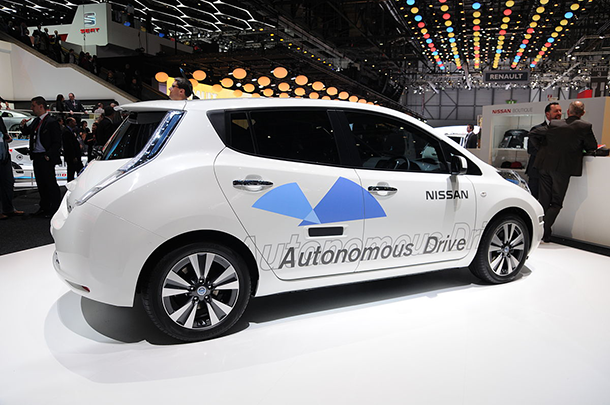
Fleets of autonomous cars might one day bring about the need for large parking lots, particularly in cities. (Photo: Norbert Aepli, Wikimedia Commons CC BY 3.0)
Looking for parking in a city is frustrating for the driver, and bad for the climate as circling cars emit unnecessary carbon dioxide. But as reporter Clive Thompson tells host Steve Curwood, fleets of coordinated, self-driving cars could bring an end to parking as we know it and help make our future cheaper, as well as more efficient, pleasant and green.
Transcript
CURWOOD: It's Living on Earth, I'm Steve Curwood. We've all been there, heading to the mall or the theater or dinner, and it ends up taking longer to find a parking space than it did to get there in the first place. This isn't just frustrating; it turns out all these cars driving in circles are bad for the climate, and bad for the air we breathe. But writer Clive Thompson thinks that one of the answers to this parking problem is not so far in the future - self-driving cars. His new essay in Mother Jones magazine is called No Parking Here, and he joins us now to discuss it. Welcome to Living on Earth, Clive.
THOMPSON: Good to be here.
CURWOOD: Clive, you say the average automobile spends the majority of its time sitting still, so if every driver is, say, sleeping the eight hours out of every 24-hour period and presumably not parking, that's a lot of time in parking spaces. Tell me about the math.
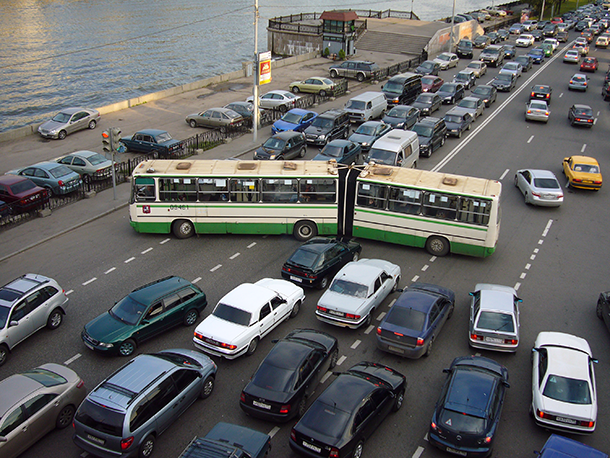
Traffic congestion in major cities like Moscow exacerbates the impact that car emissions have on climate change. (Photo: Nevermind2, Wikimedia Commons CC BY-SA 3.0)
THOMPSON: I mean the math is pretty crazy. Your car spends 95 percent of its time sitting in one place. And here is the real problem is that you've got your car at home and it does, it mostly just sits there, and then you drive it for a very brief time to work, and it has to find a place to sit there, right, and then maybe you drive it a very brief time out to dinner, but it has to have a place to sit there, and then you drive back home. In each place where the car is sitting, there needs to be parking, and this becomes an interesting geometric problem, to accommodate the amount of time those cars sit there, our society had to build way more parking than there are cars, right? And the upshot is, you know, there about 250 million cars and passenger trucks, light trucks, in the country. But the estimates are there are close to a billion parking spots. I calculated the square footage, square mileage and it's basically about the size of Connecticut is how much parking we have in the US, and there are all sorts of problems that stem from that amount of parking. I guess on just an aesthetic level parking is pretty ugly. I was talking to one architect during the story who said,“there are a lot of books are like the 10 best buildings in America or the 10 best bridges in America. There is no book of the 10 best parking lots in America because they're just ugly as sin, right?”So, they are ugly, they produce a lot of runoff, you know, like a big rain hits this massive parking lot, water's got nowhere to go so it rushes at the edges and it just rips the topsoil off of whatever field it encounters. So it causes these environmental problems.
CURWOOD: But but wait a second. If an average vehicle is parked most of the time with the motor turned off isn't that an environmental benefit? The thing isn't running?
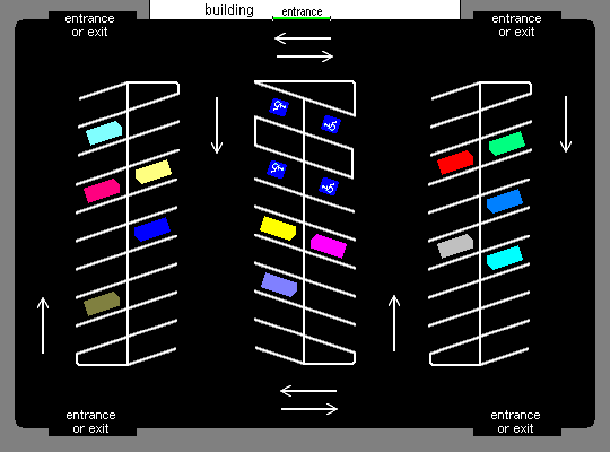
Diagram of example parking lot layout with angle parking as seen from above. White arrows show direction of allowed travel in each lane (for right-hand-drive countries). Several parking spaces closest to the building entrance are reserved for the handicapped. Cars of various colors are shown parked in some of the spaces. The obtusely pointed end indicates the front end of each car. (Photo: H. Padleckas, Wikimedia Commons CC BY-SA 2.5)
THOMPSON: You would hope so, but the problem is that actually parking lots encourage excessive driving because when people go to park in a city they have trouble sometimes finding a parking spot, right, because there's this congestion in the city and so people will sort of circle around looking for parking and studies show that it dramatically increases the amount of time we spend driving. In fact, in my neighborhood in Brooklyn, they did a study that found if you see cars driving past you - standing on the corner see cars driving past you - 30 to 60 percent of those cars are circling looking for parking. They're not going anywhere, they're no longer transferring people from point A to point B, they're now just circling, and so what this means in the city, an enormous percentage of the a carbon being put out by cars isn't getting people anywhere, it's just looking for parking.
CURWOOD: And in your article you say that the death of the ubiquitous parking space is maybe on its way thanks to self-driving cars?
THOMPSON: Yes, there are some interesting trends afoot here. So here's the thing about self-driving cars is that it's likely that by the time these things get fully licensed to be on the road which is in 15, maybe 10, 15, 20 years now, they will probably be deployed not individually - like it probably won't be you or me buying a self-driving car - it'll be probably mostly fleets, right. So, your local taxi company will just buy 200 self-driving cars, or the city might decide that it's going to create a kind of a public transit thing with cars. They'll buy thousands of self-driving cars. Uber and Lyft, they are actively researching to build their own self-driving cars, so the theory is that actually self-driving cars will mostly be fleet-based, and this will be quite interesting because you get a fleet of self-driving cars servicing a large or midsized town and what you'd effectively have is a world where you need to go somewhere, you pull up your phone and you say, I need a car, and the car sort of comes zipping right up to you and maybe there's somebody already in it – like it's intelligent carpooling, they're kind of going in the same direction as you, you guys are to split the costs, this is going to cost you almost nothing because you're sharing the cost - and so you'll still be taking cars all day long but they won't be cars you own. They'll just be those fleets that are incredibly easy to get because it just so many them out there running around. And the thing with those cars is that they are not going need to park ever. They will basically be just be driving and driving and driving around, ferrying people around in this very intelligent, efficient way. So this is the vision.
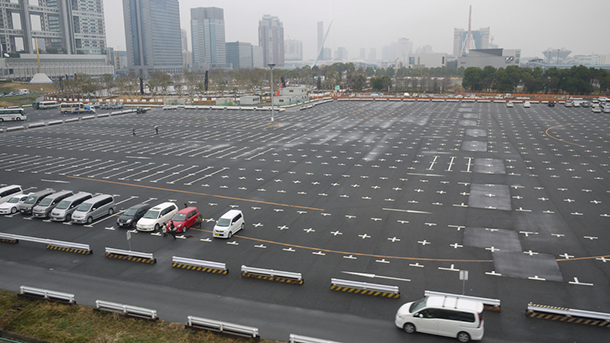
Parking lots in cities take up valuable real estate and add to the heat island effect. (Photo: Antonio Silveira, Flickr CC BY 2.0)
I was surprised by this as I had thought that people were going to buy their own self-driving cars. But over and over again, the experts I talked to, the urban planning experts, the car experts, they see this as the legit...and it's sort of makes sense when you think about it because the truth is owning a car is expensive. You've got to find somewhere to put it, you've got to pay for these repairs, and young people are buying far fewer cars than you expect at their age. They are driving personally far fewer miles that you'd expect at their age, and they're in fact actually even less likely significantly to have their driver’s licenses. So this is a cultural shift, which is also very interesting. So that's kind of a one-two punch that's moving us towards the end of parking. Self-driving cars and a generation of people that actually are less interested in owning their own car.
CURWOOD: So what happens to the ability to hang one's own personal set of dice from the mirror of the car...
THOMPSON: [LAUGHS]
CURWOOD: And then, you know, and let's face it. For older folks, you know, teenagers remember that when you got that license that it was helpful in the dating game.
THOMPSON: Yeah, this is a really interesting cultural shift. I'm 47 and in my generation, I grew up in suburban Toronto, and you still...we have a pretty good subway and bus system but you still needed to get your drivers license for a certain level of autonomy and freedom because if you wanted to kind of move around in the suburbs, you needed to be able to drive, get your family's car, take someone out on a date. So I definitely grew up with the thing that the boomers grew up with, which is the association that the car was kind of right of passage. It was you becoming a little more adult and having some autonomy and independence. That experience is far less common for young people. It's not gone. If you live in a rural area you still really need a car to get around, but more and more, younger people are living in more densely packed areas and they're discovering that in those situations they can really move around pretty easily without driving. The other thing about young people is that's pushing away from driving is that they like using their phones. For them, autonomy is about having a phone, being able to communicate all day long, when they want to, and you can't use your phone while you're driving. Those are rival activities, and they would rather use the phone than drive.
CURWOOD: Hey, so what was your experience been like in a self-driving car?

Subterranean parking lots, like this one in a Brazilian shopping mall, can save limited urban real estate but are expensive to construct. (Photo: Rachmaninoff, Wikimedia Commons CC BY-SA 4.0)
THOMPSON: It was very interesting. So, I get inside this self-driving car in the parking lot of Google, and I'm in the back seat. In the front seat there's an engineer in the driver's seat not touching the wheel. The car starts driving off and I'm looking at the front wheel and basically it's as if a ghost is driving it. The wheel is turning itself. At first it was...for the first like three of four minutes it's pretty unsettling because it really feels weird to have no one, no human driving that car, but it quickly became kind of boring because it turns out that Google's cars are very defensive drivers. And so we'd be driving along and going along fairly fast but the instant someone starts to edge out into our lane, our car would immediately slow down and give way. So, in one sense it actually very quickly became boring and at first I thought, well, this is going be hard. I'm trying to write a story. It's supposed to be exciting. But I became convinced that boring is what you want. When it comes to driving, you want driving to be predictable and safe and boring.
The one thing that most computer scientists and urban traffic experts say that will make them even safer is that if there's actually a lot of them on the road because if all the cars are robotic and if they can talk to each other, well then they can start to optimize for good behavior and minimize bad behavior. They aren't going to make any stupid calls, but they're not going to make any emotional decisions. You can even do things...this is pretty funny...there's a guy at the University of Austin who has done these modelings where, he says, you know, if you have all robot cars on the road, maybe you need stop signs because the cars can just sort of weave through each other right? They can just go right into the intersection and just go right through and slow down and speed up to avoid other cars. And he's done these little animations to show what it looks like, and it's just wild. And the upside is the traffic really keeps moving. So one of the other weird upsides of self-driving cars is that we could actually move around a lot more quickly and efficiently which again reduces emissions because there's a huge amount of emissions that come from a car slowing down and then speeding up again at an intersection.

Parking spaces in front of small shops are being repurposed as “parklets” in cities like San Francisco. (Photo: Mark Hogan, Flickr CC BY-SA 2.0)
CURWOOD: So, one big benefit from self-driving cars would be to eliminate essentially parking spaces for vehicles. So what do you do with all that land that becomes available now?
THOMPSON: It's a super interesting question. I mean most downtown cores are about 31 percent parking right? So think about that. That's prime land. So what would we do if we freed up 31 percent fresh land to do something? What would you do it? Well, maybe the city could finally do some of the things we've always want to do and we can build more housing. Housing in markets, certainly in overheated markets like San Francisco, Chicago, Boston, New York, desperate for more housing, or you can convert some of it to parks.
I mean there's this little parklet program in San Francisco - it's a real blast - where they they let a merchant if you want to - if you've got a coffee shop - you can pay the city a certain amount per year for the parking spot in front of your café and you're allowed to turn it into a park. And so there's all these funny little beautiful parks where they've grassed it over, put in maybe like a little tree and stuff or they maybe put up a bench and there's kind of a sitting area and if you were able to make it green, if you could throw in plants, throw in grass in that area, you could also cool cities down because all that 31 percent it's all asphalt and that heats up cities, what they call the urban heat island effect. Sun hits the asphalt, heats it up, it's like a battery storing heat, sun goes down, it keeps a city hot at night. Well, if you have grass and trees it doesn't do that, it's cools things down a lot. That would make it way more fun and livable and again have fantastic environmental effects because now you're doing much less air-conditioning using less electricity for air-conditioning, so you know the sort of fun things that begin to cascade out of getting rid of parking. It's delightful. There's all these different layers.
CURWOOD: Yeah on the real estate side, you could even take it to the bank. Famously here in Boston a couple years ago there was an auction of two rare tandem parking spaces. In other words, front to back, behind a building on Commonwealth Avenue in the ritzy Back Bay neighborhood. Those spots went for $560,000, more than a half a million dollars.
THOMPSON: [LAUGHS] Exactly. That's how a really overheated market...we're talking about billions and billions of dollars worth of land, and the one thing is, if we want to manage this wealth - and cities have to start thinking now because they may have to make these decisions 15 years from now on what they have to do with that stuff - and there will definitely be a lot of interests. There will be developers that want it, there will be school boards that want it, there will be parks people that want it, so we've got to start having these conversations now so that we make reasoned and good equitable decisions 15 years down the line, if and when this starts happening.
CURWOOD: Clive, how do you see this system dovetailing with mass transit?
THOMPSON: In one sense you can already see it happening, which is that down in San Francisco which is where Uber is really big, a very significant chunk of their rides, I think almost one third of their rides, begin or end at a station on the rail lines. So what people are using Uber for is to get them to public transit and so what public transit really needs is to understand. They're trying to wrestle with what's the demand for these services because they actually want to build public transit in a way that works with these mobility things to actually enhance both, right? You could easily imagine that if you now were confident as a city that you didn't have to worry maybe quite so much about building some bus lines because these types of services were going to be useful in well-to-do neighborhoods, you could focus the bus lines on areas where people are less likely to use these services, but you can also build a rail confident that people will be able to get to and from the rail more quickly.

Idling while searching for a parking space contributes to smog, seen here obscuring downtown L.A.’s skyscrapers. (Photo: Jay Peeples, Flickr CC BY-NC 2.0)
The other thing cities are thinking about is OK, there is a significant chunk of the population that is unbanked, right, so they do not have bank cards, they do not have credit cards in more low-income sectors. Well, the price of these on-demand ride services is dropping quite sharply. If you do an Uber Pool, you might only take $3 or $4 bucks for a ride. That actually gets it to where low-income families could find an amenable way to get around, but they need a card to participate so that I know the city of San Francisco is already thinking, well so are there things we could do, could we set up some sort of card system that would work with public funds or what not so that they can get people to participate in this. So, really what you're seeing is the public transit systems are thinking how can we, if this is a mass movement trend, how can we work with it so that it actually aids our goal of moving people around efficiently.
CURWOOD: Clive, give us the Rip van Winkle report here. You fall asleep, presumably not at the wheel, and you wake up now in a couple of decades. What do you expect to see on city streets?
THOMPSON: You know, I think 20 years from now, if the predictions that everyone has been giving me hold up, here's what we're going to see. We'll see cities where you look at the street and the street is really full of a lot of traffic, like this is not the absence of traffic, if anything else it might be even more cars whizzing around, but they're never stopping, they're never parking. You would decide, OK, I need to go across town, you pull out your phone and within like 15 to 20 seconds, a car would pull up and get you. Like not five minutes, we're talking seconds, a car would pull up. You jump in, there's someone there, you go across town. You get across town pretty quickly and you go through these intersections that maybe don't have lights anymore, you just zip right through, and when you get out of the car you might be stepping onto what is essentially a little park on the edge of the road, right, because that's what we've done with that space now.
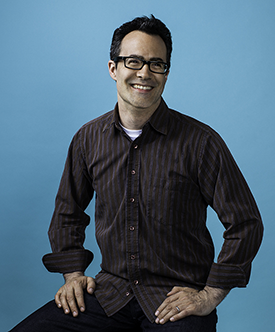
Clive Thompson is a writer for Mother Jones magazine. (Photo: Catalina Kulczar)
The other thing though you'd find is that there would definitely be some probably be some significant labor dislocation. You'd wake up in a world where millions and millions of people who used to be employed in jobs that paid, not great but pretty well, to drive cars around, to drive trucks around, they do not have those jobs anymore, and you could imagine that going pretty poorly if there's not a decent public policy to try and figure out how to encourage economic growth that gives those people jobs. If they don't have jobs we could have an awful lot of turmoil in that world, great mobility but at the cost of significant economic and social upheaval.
CURWOOD: Clive Thompson is a freelance journalist, blogger and science and technology writer, his piece titled "No Parking Here" appears in the current issue of Mother Jones magazine. Thank you so much for taking the time today, Clive.
THOMPSON: Great conversation. I had a lot of fun.
Links
Retail parking lots, environmental impacts and development policies: Research roundup
Read Clive Thompson’s piece in MotherJones
How Driverless Cars Could Turn Parking Lots into City Parks
How self-driving cars can transform Los Angeles, starting with its parking
Building the city of the future through smart, connected urban transport
Living on Earth wants to hear from you!
Living on Earth
62 Calef Highway, Suite 212
Lee, NH 03861
Telephone: 617-287-4121
E-mail: comments@loe.org
Newsletter [Click here]
Donate to Living on Earth!
Living on Earth is an independent media program and relies entirely on contributions from listeners and institutions supporting public service. Please donate now to preserve an independent environmental voice.
NewsletterLiving on Earth offers a weekly delivery of the show's rundown to your mailbox. Sign up for our newsletter today!
 Sailors For The Sea: Be the change you want to sea.
Sailors For The Sea: Be the change you want to sea.
 The Grantham Foundation for the Protection of the Environment: Committed to protecting and improving the health of the global environment.
The Grantham Foundation for the Protection of the Environment: Committed to protecting and improving the health of the global environment.
 Contribute to Living on Earth and receive, as our gift to you, an archival print of one of Mark Seth Lender's extraordinary wildlife photographs. Follow the link to see Mark's current collection of photographs.
Contribute to Living on Earth and receive, as our gift to you, an archival print of one of Mark Seth Lender's extraordinary wildlife photographs. Follow the link to see Mark's current collection of photographs.
 Buy a signed copy of Mark Seth Lender's book Smeagull the Seagull & support Living on Earth
Buy a signed copy of Mark Seth Lender's book Smeagull the Seagull & support Living on Earth

